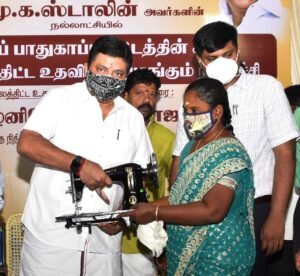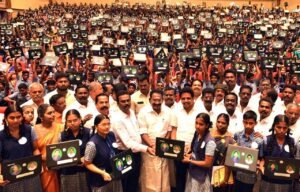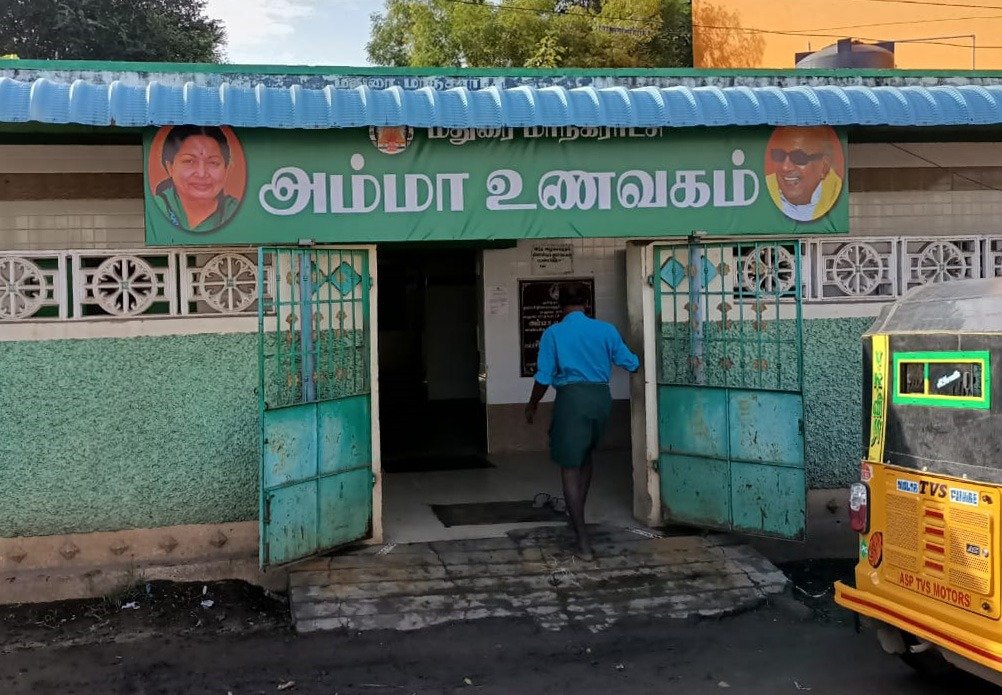Read in : தமிழ்
The DMK government recently announced that the community kitchen scheme of Amma Unavagam would be supplemented by Kalaignar Unavagam, named after DMK leader Kalaignar Karunanidhi. Five hundred Kalaignar Unavagams were to be opened across Tamil Nadu, the government announced. Following this, in Madurai, overenthusiastic DMK workers put up a flex board at an Amma Unavagam. Since it would be incongruous to remove Jayalalithaa’s photo from the Amma Unavagam sign, they let both stay until DMK men removed it a bit later.
Many saw this only as the latest instance of the competitive welfare politics of the two Kazhagams. While welfare or populism, as some academics would call it, remains a cornerstone of both the parties, there is a key difference between the two parties. For the DMK, welfare is the means to a larger goal of Dravidian empowerment and social justice for which the governments it runs devote a variety of policies. For the AIADMK, however, barring the electorally important reservation policy, welfare is the means and the end.
While welfare or populism, as some academics would call it, remains a cornerstone of both the parties, there is a key difference between the two parties. For the DMK, welfare is the means to a larger goal of Dravidian empowerment and social justice for which the governments it runs devote a variety of policies. For the AIADMK, however, barring the electorally important reservation policy, welfare is the means and the end.
Both the DMK and its archrival AIADMK have made populist schemes a must in their election manifestos. If DMK announces rice at Rs 2 per kg, the AIADMK would make it free in its manifesto. They keep enhancing the schemes introduced by each other. Karunanidhi, for instance, introduced the egg – laddu for vegetarians – in MGR’s noon meals scheme when he came to power after a long gap in 1989.

DMK’s present finance minister P T R Palanivel Thiagarajan gives away sewing machines
While the anti-Hindi agitation provided the political firepower for the DMK to come to power in 1967, it was the promise of subsidized rice that truly turned the turnstiles of power for the party. The nationwide trend of Congress losing to combinations of ideologically opposed parties worked in Tamil Nadu also that year. From the conservative Swatantra Party of Rajaji to the CPM, many came to support the DMK’s march to power. Once there, the party understood welfare as a key policy element. Yet, for the DMK, social justice has been the broader aim. For instance, in his first term as chief minister, Karunanidhi launched Kannoli Thittam – free eye surgeries for blind people — rehabilitation of beggars, and providing cycle rickshaws for rickshaw pullers.
The approach to welfare politics may well indicate the true DNA of the two parties. Though the AIADMK was born out of a vertical split in the DMK, the AIADMK’s support base and geographical reach were different. While the DMK’s strongholds were and are the Cauvery Delta and northern Tamil Nadu, for the AIADMK, the south and the west are still its strongholds. While the two parties do their best to gain seats in each other’s strongholds, their bases are different. Similarly, the AIADMK, until recently at least, naturally commanded the support of the poorest among the population and the most marginalized. Fishermen, tribals and women were naturally drawn towards the AIADMK. A key reason for that could be the mammoth welfare schemes it has pioneered. MGR, for instance, converted Kamaraj’s Midday Meal Scheme into Nutritious Meal Scheme in 1982 into a massive statewide feeding programme. A political analyst says that with one stroke, MGR touched the hearts of lakhs of mothers who cannot stand their children starving.
MGR’s approach seemed to come more from the heart, not ideology. MGR, for instance, spoke of introducing the economic criteria in reservation so it was no more purely caste-based but beat a hasty retreat after his defeat in the 1980 Lok Sabha elections. Jayalalithaa, though, having drawn the right political lessons, aligned with DK’s K Veeramani to have the Tamil Nadu reservation policy written into the statutes through a special sitting of the Parliament. But, barring this, ideological nuances do not quite interest the party.

AIADMK distributed laptops to students. It was to help them in their studies.
When it was founded, the AIADMK made its mark by replacing the Congress in the south and west of Tamil Nadu, not as a head-to-head competitor to the DMK in its Delta and northern strongholds. Dravidian ideology did not drive a large share of the AIADMK votes. Even today, the thevar community that strongly backs the AIADMK has been lukewarm at best to Dravidian ideology. Its towering leader, Muthuramalinga Thevar was a bitter critic of the Dravidian parties and a staunch advocate of spiritualism.
The approach to welfare politics may well indicate the true DNA of the two parties. Though the AIADMK was born out of a vertical split in the DMK, the AIADMK’s support base and geographical reach were different. While the DMK’s strongholds were and are the Cauvery Delta and northern Tamil Nadu, for the AIADMK, the south and the west are still its strongholds.
Once food security was addressed, both the parties moved on to other modes. Distributing goats, laptops and two-wheelers made the AIADMK immensely popular, so were the DMK’s television set giveaways. Even as the DMK instituted such welfare, it passed legislation to ensure non-brahmins could become temple priests. This was part of Periyar’s vision who also advocated equal rights for women while inheriting property. Karunanidhi passed the Hindu Succession (Tamil Nadu Amendment) Act in 1989, sixty years later Periyar passed a resolution at a conference for it.
Read in : தமிழ்
